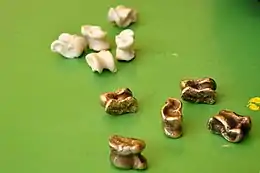Astragalomancy
Astragalomancy, also known as astragyromancy, is a form of divination that uses dice specially marked with letters or numbers.
| Look up astragalus in Wiktionary, the free dictionary. |

.jpg.webp)
Originally, as with dice games, the "dice" were knucklebones or other small bones of quadrupeds. Marked astragali (talus bones) of sheep and goats are common at Mediterranean and Near Eastern archaeological sites, particularly at funeral and religious locations.[1] For example, marked astragali have been found near the altar of Aphrodite Ourania in Athens, Greece, suggesting astragalomancy was performed near the altar after about 500 BC.[2]
Also known as cleromancy, the practice of contacting divine truth via random castings of dice or bones stretches back before recorded history. The Metropolitan Museum of Art displayed bone "dice" (hakata) used by the Shona people of southern Africa.[3] They have been in use for thousands of years, and remain extant.
Since astragalomancy is a form of sortition, numbers are scrawled into the dice; the numbers are associated with letters, thus bearing on the questions of the diviner. The diviner then casts the dice, resulting in a random sequence of numbers.[4] The diviner interprets this sequence according to certain rules – usually rules specific to his/her religion (e.g. Buddhism).
Astragalomancy is considered the twin of pessomancy (also known as psephomancy) – another act of divination which uses colored or marked pebbles as opposed to numbered dice. These pebbles are either thrown out of a bag after shuffling or drawn from the bag at random. The interpretation of the colors or symbols relate to issues such as health, communications, success, and travel.[5]
In Tibetan Buddhism
The Dalai Lama is reported as using the mo, balls of dough in which have been placed pieces of paper with possible "choices" written on them, to help in making important decisions.[6] Tibetan divination has long featured the mo in making everyday decisions, too.[7] There are books written by various lamas on interpretations for the casting of dice.
Notes and references
- Reece, David S. (2000). "Worked Astragali" (PDF). Kommos: an excavation on the south coast of Crete volume IV: the Greek sanctuary. Princeton: Princeton University Press. pp. 398–401.
- Reece, David S. (1989). "Faunal remains from the altar of Aphrodite Ourania, Athens". Hesperia. American School of Classical Studies at Athens. 58 (1): 63–70. doi:10.2307/148320. JSTOR 148320.
- "Divination Dice (Hakata)". The Metropolitan Museum of Art. Archived from the original on 2008-05-09. Retrieved 2008-07-31.
Sets of dice (hakata) are the quintessential Shona instruments used to divine the source of illness or personal misfortune. These consist of a series of four miniature tablets, made of wood, ivory, or bone, each with a distinct design motif inscribed on one side. According to Shona conceptions of experience, personal difficulties—ranging from unemployment or poor grades in school to the death of one's livestock—may all be attributed to some spiritual agency. Consequently, a distinction is made between medical treatment of certain ailments and a diviner's probing analysis and diagnosis of the ultimate cause of a client's problems.
- "Astragalomancy." Encyclopedia of Occultism and Parapsychology. Ed. J. Gordon Melton. 5th ed. Vol. 1. Detroit: Gale Group, 2001. 100. Gale Virtual Reference Library. Web. 27 Feb. 2015.
- "Pessomancy (or Psephomancy)." Encyclopedia of Occultism and Parapsychology. Ed. J. Gordon Melton. 5th ed. Vol. 2. Detroit: Gale Group, 2001. 1202. Gale Virtual Reference Library. Web. 28 February 2015.
- Evan Osnos, Profiles, “The Next Incarnation,” The New Yorker, October 4, 2010, p. 63
- Tseten, Dorjee. "Tibetan art of divination". The Office of Tibet. Archived from the original on 2008-05-04. Retrieved 2008-07-31.